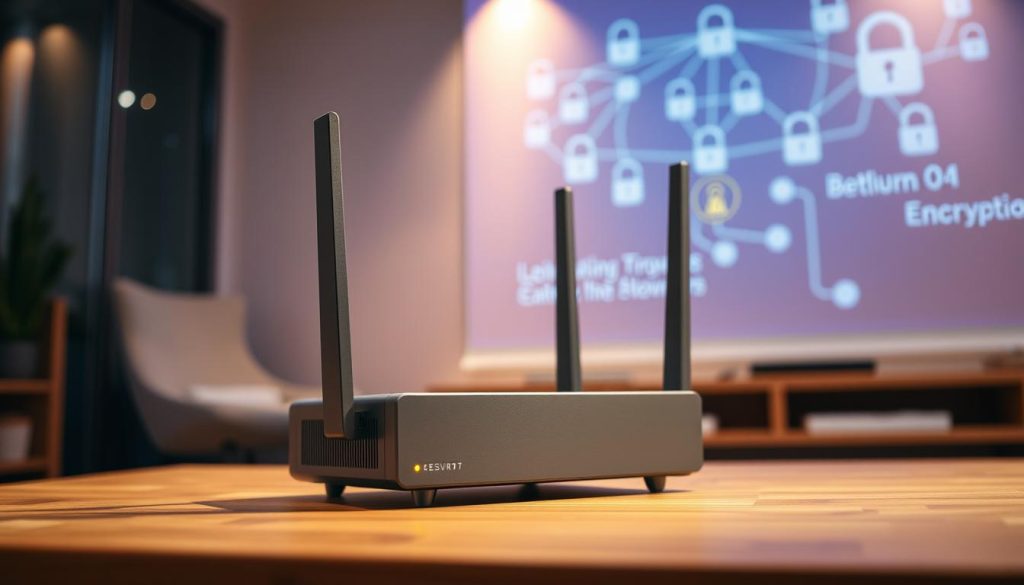As you use LTE/5G Routers more, the chance of remote attacks grows. It’s key to keep your network safe to protect your data and devices.
Remote attacks are becoming more common. It’s vital to use robust security measures for your LTE/5G Routers. This means knowing the weak spots and acting fast to keep your network safe.
Key Takeaways
- Understanding the risks associated with LTE/5G Routers
- Implementing robust security measures to protect your network
- Recognizing the importance of securing your devices from remote attacks
- Taking proactive steps to safeguard your LTE/5G Routers
- Staying informed about potential vulnerabilities
Understanding LTE and 5G Router Security Risks
LTE and 5G routers offer fast internet and ease of use. But, they also bring big security risks. These technologies are fast and have low latency. Yet, they expose users to many security threats.
One big worry is remote attacks on LTE and 5G routers. These routers are online, making them easy targets. This is especially true since we rely on them for important communications and data.
- Inadequate security settings
- Old firmware
- Weak passwords
- Not getting regular security updates
There are common attacks on LTE and 5G routers. These include:
| Type of Attack | Description | Impact |
|---|---|---|
| Brute Force Attacks | Attackers try to guess passwords by trying many times. | They can get into the router and the network. |
| Denial of Service (DoS) Attacks | They send so much traffic that the router can’t work. | This makes the internet hard to use. |
| Man-in-the-Middle (MitM) Attacks | They listen in on the router and devices talking to each other. | They can steal data and listen in on conversations. |
Knowing about these risks is the first step to keeping your LTE/5G router safe. By understanding the vulnerabilities and attacks, you can protect your network and devices better.
Best Practices for Securing Your LTE/5G Router
To keep your network safe, it’s key to follow the best practices for LTE/5G router security. Securing your LTE/5G router involves several important steps. These steps not only protect your device but also keep your entire network safe.
First, changing your router’s default passwords is crucial. Default passwords are often found online, making it easy for hackers to get into your router. By changing these passwords, you greatly improve your router’s security.
Another important step is to regularly update your router’s firmware. Firmware updates often include fixes for security issues found since the last update. Keeping your firmware updated ensures you have the latest security patches.
Using WPA3 encryption is also a must. WPA3 is the newest wireless security protocol, offering better protection against cyber threats. If your router supports WPA3, it’s best to use it over older protocols like WPA2 or WEP.
| Security Protocol | Security Level | Compatibility |
|---|---|---|
| WEP | Low | High |
| WPA2 | Medium | High |
| WPA3 | High | Medium |

Also, setting up your router’s firewall correctly and using a VPN can add extra security. It’s also good to keep an eye on your network for any unusual activity.
By following these steps, you can greatly enhance the security of your LTE/5G router. This will help protect your network from potential threats.
Setting Up a Secure Network
Setting up a secure network is key to protecting your LTE/5G router from cyber threats. One important step is to create a separate guest network for visitors. This keeps your main network safe by blocking unauthorized access to your devices and data.
Creating a Guest Network: To set up a guest network, log in to your router’s admin panel. Then, go to the wireless settings and turn on the guest network feature. Choose a unique SSID and password for it. This keeps your main network safe even if the guest network is hacked.

Another important step is disabling remote management access to your router. Remote management lets admins access the router from anywhere. But, it’s a big security risk if not secured well. Turning it off when not needed stops hackers from getting into your router.
Disabling Remote Management: To disable remote management, go to your router’s admin panel. Then, find the advanced settings and look for remote management or remote access. Turn it off by unchecking or toggling it off. Save your changes to apply the new settings.
Using a strong network SSID and password is also crucial. Don’t use your name, address, or common words for your SSID and password. Instead, choose a complex SSID and a strong password. Include uppercase and lowercase letters, numbers, and special characters in your password.
| Security Measure | Description | Benefit |
|---|---|---|
| Creating a Guest Network | Isolates visitors from the main network | Reduces risk of unauthorized access |
| Disabling Remote Management | Prevents external access to router settings | Enhances security against hacking attempts |
| Using a Strong Network SSID | Complex identifier for your network | Makes it harder for hackers to guess |
By following these steps, you make your LTE/5G router much more secure. This protects your network from many threats.
Monitoring Your Network
Regularly checking your LTE/5G router can boost its security. Use tools to watch network activity and spot threats.
Network monitoring tools help find odd patterns or activities that might mean a breach. Look out for strange devices, unusual login tries, or sudden router setting changes.

If you think there’s a breach, act fast to protect your network. This might mean changing your router’s password, updating its software, or blocking odd devices.
To keep an eye on your network, follow these steps:
- Check your router’s logs often for odd activity.
- Use network monitoring software to track device activity.
- Set up alerts for unusual login attempts or changes to your router’s settings.
Being proactive and alert can lessen a security breach’s impact. This ensures your LTE/5G router stays cybersecure.
Educating Users about Security
It’s important for users to know how to protect your LTE/5G Router from hackers. They need to understand the risks and how to avoid them. This is the first step in keeping your network safe.
Tips for Secure Internet Browsing: When online, users should be careful. They should not click on suspicious links or download files from unknown places. Always use https connections when you can.

Keeping users up-to-date with security tips is key. This can be through workshops, online sessions, or emails about new threats. It helps everyone stay safe.
Teaching users about security can greatly lower the chance of attacks. It’s a smart move that works with other safety measures. Together, they make sure your Router is well-protected.
Firewall Configuration for LTE/5G Routers
Securing your LTE/5G router starts with setting up its firewall. This blocks unauthorized access. A good firewall keeps your network safe by stopping bad traffic.
To begin, enable the built-in firewall on your LTE/5G router. Most modern routers have this feature but it’s not always on by default. Make sure it’s active in your router’s settings. This one step can greatly boost your network’s safety against remote attacks on routers.
Next, you need to tweak the firewall rules. This means deciding what traffic to let in or block. For example, you might block certain ports to stop hackers. But be careful not to block too much, or it could mess up your network.
- Review your router’s default firewall settings.
- Configure rules based on your security needs.
- Regularly update your firewall settings to adapt to new threats.
Keeping your firewall up to date is key. Manufacturers often release updates that boost security. It’s important to keep your router’s firmware current to stay safe.
By following these steps, you can make your LTE/5G router much more secure. This protects your network from remote attacks and keeps your connection safe.
Utilizing VPNs for Enhanced Security
Using a VPN with your LTE/5G router adds a crucial layer of protection for your data. A Virtual Private Network (VPN) encrypts your internet traffic. This makes it hard for hackers to get your data. This is very important for LTE/5G routers, used in mobile or remote settings where security risks are higher.
Benefits of Using a VPN with Your LTE/5G Router include enhanced security and privacy. A VPN encrypts your internet traffic, protecting your data from unauthorized access. This is especially crucial when using public Wi-Fi networks or handling sensitive information.
To set up a VPN with your LTE/5G router, follow these steps:
- Choose a reputable VPN service provider that supports router configurations.
- Configure the VPN on your router using the provider’s instructions.
- Ensure that all devices connected to the router are set to use the VPN connection.
By using a VPN, you can greatly improve your LTE/5G router’s security. This protects your data and keeps your privacy safe. This step is key in today’s world, where security threats are common.
Key Considerations when picking a VPN for your LTE/5G router include encryption level, server locations, and router model compatibility. It’s also important to keep your VPN updated for ongoing security.
The Role of Antivirus and Security Software
Antivirus and security software are key in stopping remote attacks on your LTE/5G router. By installing and keeping it updated, you boost your network’s safety.
Key Benefits of Antivirus and Security Software
- Detects and removes malware
- Blocks unauthorized access to your network
- Provides real-time protection against new threats
- Enhances overall network performance and stability
To keep your LTE/5G router safe, follow these steps:
- Pick a trusted antivirus and security software that fits your router’s OS.
- Set the software to scan your network often for threats.
- Make sure it updates automatically to fight the latest malware and vulnerabilities.
- Check the software’s settings and scan results regularly to spot and fix security problems.
Top antivirus and security software for LTE/5G routers include Norton Security, Kaspersky Internet Security, and Bitdefender Antivirus. When choosing, look for:
- Advanced threat detection
- Firewall protection
- Anti-phishing capabilities
- Regular updates and support
Using the right antivirus and security software greatly lowers the chance of remote attacks on your LTE/5G router. It keeps your network safe and stable.
Managing IoT Devices on Your Network
Securing your IoT devices is key to protecting your network. As more IoT devices connect, the risk grows. So, managing these devices well is crucial for Router Cybersecurity.
Using guest networks is a smart move. It keeps IoT devices separate from your main network. This helps keep your data safe.
Watching IoT traffic is also important. It helps spot any odd activity that might mean a security issue. Tools for monitoring the network can catch threats fast.
Benefits of Using Guest Networks for IoT Devices
- Enhanced security through network segregation
- Reduced risk of IoT devices being used in botnet attacks
- Simplified management of IoT devices
Here are some tips to boost IoT security:
- Regularly update the firmware of your IoT devices
- Use strong, unique passwords for each IoT device
- Disable any unnecessary features or services on your IoT devices
| Security Measure | Description | Benefit |
|---|---|---|
| Guest Networks | Segregate IoT devices from the main network | Prevents IoT devices from accessing sensitive data |
| Regular Firmware Updates | Keep IoT device firmware up-to-date | Protects against known vulnerabilities |
| Strong Passwords | Use unique, complex passwords for IoT devices | Reduces the risk of unauthorized access |
By following these steps, you can make your IoT devices much safer. This, in turn, makes your whole network more secure. Good management of IoT devices is a big part of keeping your Router Cybersecurity strong.
The Future of Router Security
The world of cybersecurity is always changing. This is pushing the development of LTE/5G Router Defense forward. As new tech comes out, we face new security risks. It’s important to keep up with the latest in router security.
Technologies like Artificial Intelligence (AI) and Machine Learning (ML) are now part of Router Security. They help routers learn from past attacks and get ready for new ones. This makes networks safer.
The trend of Zero Trust security is also growing. It treats every device and user as a possible threat. It checks their identity and permissions before letting them into the network. Using Zero Trust can really help strengthen your LTE/5G Router Defense.
To get ready for future security issues, update your router’s firmware often. Also, stay current with the latest cyber threats. This way, your network will stay safe and strong against new dangers.
By using these new technologies and trends, you can make your Router Security better. This will help protect your network from the changing world of cybersecurity.
Conclusion: Proactive Security Measures
Keeping your LTE/5G router safe is a constant task. By following the steps in this article, you can lower the chance of remote attacks. This makes your Secure LTE/5G Routers more secure.
It’s important to keep up with the latest security updates for your LTE/5G Routers. Make sure to update your router’s firmware regularly. This keeps your network safe and secure.
Protecting your LTE/5G router means always being on the lookout for threats. Stay alert and proactive to keep your network safe. This way, your LTE/5G Routers will stay protected from new dangers.

